Abstract paintings are metapaintings. A metapainting is a painting about painting. A metapainting may represent itself, the process of its creation, its materiality, the conventions of art, the gallery where it is hung, the artwork around it, and the place of art and artist in society. Diego Velasquez’s Las Meninas does all these things and more, but Velasquez’s painting is a metapainting because of its subject matter, rather than its form or style. Most other paintings by Velasquez are not meta, but are naturalistic representations. Abstract paintings, in contrast, are inherently meta. (You can see Velasquez’s painting below.)
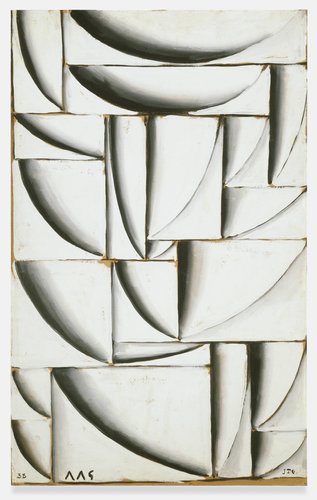 Abstract paintings are meta because they are about themselves. The titles of many abstract paintings show that they are their own subject matter, for example Constructivist Painting No. 8 by Joaquin Torres-Garcia from 1938. The metapainting also emphasizes the process of its creation, namely its construction in the word “Constructivist.” Similarly, Jackson Pollock’s Square Painting refers to paint being poured into a square (the process being what matters most for Pollock). All abstract paintings are metapaintings.
Abstract paintings are meta because they are about themselves. The titles of many abstract paintings show that they are their own subject matter, for example Constructivist Painting No. 8 by Joaquin Torres-Garcia from 1938. The metapainting also emphasizes the process of its creation, namely its construction in the word “Constructivist.” Similarly, Jackson Pollock’s Square Painting refers to paint being poured into a square (the process being what matters most for Pollock). All abstract paintings are metapaintings.
Let me clarify that I am using “abstract” here in the strict sense of a non-figurative painting, a painting that does not present an object outside itself. Although many call Picasso an abstract painter, this is inaccurate. He was a figurative painter — he presented images: guitars and coffee pots, bull fights,and rape. Of course, he challenged convention and drew attention to texture and shape, and these aspects are meta. While he employed meta-elements in all of his work, some of his paintings, for example, his Las Meninas series are metapaintings, in fact meta-metapaintings, but they are not abstract.)
A metapainting often draws the viewer’s attention to the the canvas, the paint, the texture and the shapes. Robert Rauschenberg’s infamous White Paintings — basically three apparently blank pictures side by side — draw attention to their canvases. (Actually, instead of being blank, the canvases are painted white and must be repainted periodically to maintain their pristine whiteness. Read more about the White Paintings in my post, “The Lack of Blank Spaces.”) These paintings also questioning the basic assumption — one that seems too obvious to question — that a painting must have an image. A shocking idea even after all these years!
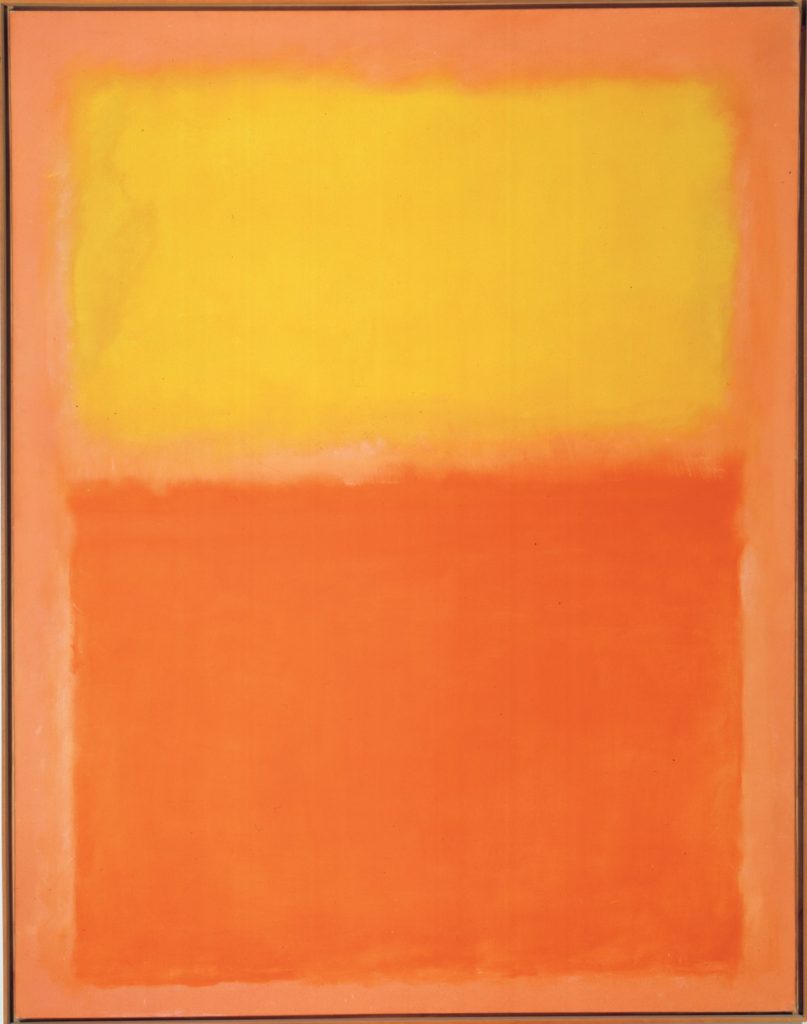
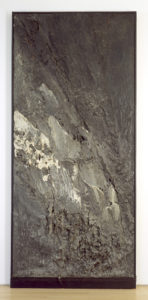 Many abstract paintings refer to the paint itself, as does Mark Rothko’s Orange and Yellow (painted in 1956). For Jay DeFeo’s Incision (shown on the right), the title does not refer to the texture, but the texture is so exaggerated, as to heighten a viewer’s awareness of it. Apparently, it took her four years to apply all that paint, because she worked on the painting from 1958 to 1961. The emphasis on shapes can be seen in Josef Albers’ Study for Homage to the Square (1972, below).
Many abstract paintings refer to the paint itself, as does Mark Rothko’s Orange and Yellow (painted in 1956). For Jay DeFeo’s Incision (shown on the right), the title does not refer to the texture, but the texture is so exaggerated, as to heighten a viewer’s awareness of it. Apparently, it took her four years to apply all that paint, because she worked on the painting from 1958 to 1961. The emphasis on shapes can be seen in Josef Albers’ Study for Homage to the Square (1972, below).

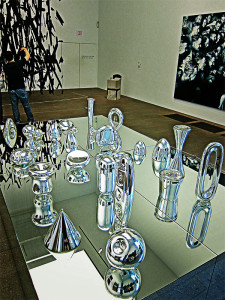 Although, I am straying a bit from painting, the sculpture “Model for Total Reflective Abstraction” by Josef McElheny (2003), not only emphasizes shape, but reflects itself, the gallery and the paintings around it. (Photo by Omar Rodriguez-Rodrigues. Read more about it on my post, Metaphotos of a Meta-Sculpture.)
Although, I am straying a bit from painting, the sculpture “Model for Total Reflective Abstraction” by Josef McElheny (2003), not only emphasizes shape, but reflects itself, the gallery and the paintings around it. (Photo by Omar Rodriguez-Rodrigues. Read more about it on my post, Metaphotos of a Meta-Sculpture.)
Truly abstract paintings then are always metapaintings, because they are about themselves, their materiality and the process of their production.
* * *
(All paintings discussed here are from the San Francisco Museum of Modern Art. McElheny’s sculpture appeared in the De Young Museum.
Read more about metapaintings in my posts Las Meninas: A Meta-Paining, If Not a Pipe, Then What? Magritte’s Meta-painting, Halfway: A Meta-Painting by Tofu St. John, and The Lack of Blank Spaces: Cage’s 4’33” and Rauschenberg’s “White Paintings.”
Read about meta-murals in these posts: The Making of a Fresco Showing the Building of a City: Diego Rivera’s Meta-Mural, A Meta-Mural on Clarion Alley: Lo Llevas por Dentro by Jet Martinez, Repainting the Tenderloin: Mona Caron’s Meta-Mural “Windows Into the Tenderloin.”
Read these excellent posts on meta-painting from Museo del Prado: Meta-Painting: A Journey to the Idea of Art and Steffan Shaffeld: Part Three: Exercises 3.3: Meta-Pictures, and read the book The Self-Aware Image: An Insight into Early Modern Meta-Painting.
Take a look at my abstract photos in my post Abstract Art Reinterpreted in Photography and the book #abstract.)
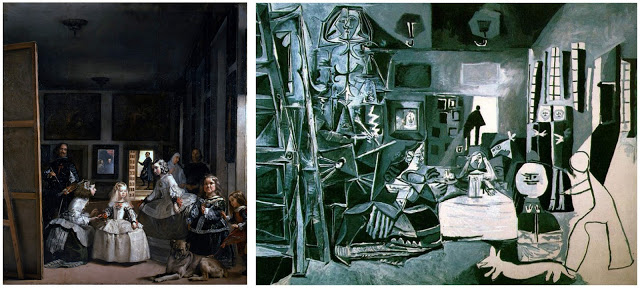
I just visited Rauschenberg’s studio in Florida (luck, mostly!) and I have always loved abstract art. Maybe it’s the meta-ness that I respond to, but I think it’s more the purity and simplicity of a lot of the work. Rothko has always been a favorite.
By the way, have you read Bluebeard by Vonnegut? Any discussion of abstract artists always reminds me of that book. Lots of great ideas within it.
I am jealous of your visit. I haven’t read Bluebeard, but I love Vonnegut. I haven’t written anything about him here, but he definitely deserves to be on a metablog!
Hi! Just loved the idea. I’m wrting a dissertation and would like to quote. Do you have it in a paper, book or something that I could use for that? Also, do you have references, bibliography that I could read? Thanks
Well thanks for the compliment. The idea that an abstract painting is a meta-painting is my own, although probably influenced by my friend Ian Latta. As for other ideas for what meta means you can find my reading list under “Hop on the Silly-Bus” and “Summer Extension” and “Further Readings,” or under other posts in which I used other sources. Looking at “An Overview of Metafiction” will lead you through some of my ideas to posts and the sources that influenced them. Let me know if you have any specific questions: ronosaurusrex@hotmail.com.
Meta-painting is not simply narcissism, nor simply self-reference. If I look into a mirror to see what I look like, this is not self-reflection. Self-reflection means stepping back from your everyday self-consciousness. No abstract painting is able to self-reflect because it can not look at itself, by itself. Indeed, it needs an external element so as to step back out of its own framework. The Albers’ squares within squares is a compositional use of iteration, not an example of meta-painting. Meta-painting is a rare animal indeed. By your definition, it becomes as common as wall paper, and as equally mindless.
Dan Davidson email your response to me at dan@dandavidsonstudio.com.
Thanks for your comment, Dan. You make several good points. Nevertheless, if we define a meta-painting as a painting about painting, then abstract paintings are undeniably about painting, making the viewers aware of the paint and canvas, the materials which form the painting, as well as the process (think of Pollock’s drip paintings), rather than being naturalistic representations of external objects. A painting with a naturalistic illusion is not a meta-painting because it causes the viewer to look beyond the painting to something else.
You define a meta-painting as a self-reflective painting. I do acknowledge that there are different degrees of self-reflection in meta-paintings. Albers’ squares are not as intensely self-aware as Velasquez’s “Las Meninas,” which is about the act of painting, the societal position of the artist, the act of posing, the display of paintings, and the viewing of paintings. (See my post: http://ronosaurusrex.com/metablog/2010/04/17/las-meninas-a-metapainting/) Albers paintings of squares does not reflect on painting in the same complex ways, I grant you, but it is self-reflective because it is a painting about paint.
By my definition, meta-paintings are common, but does this lessen the value of a meta-painting? Meta-songs, songs that reference themselves, other songs, or music, are in fact quite common, yet there is a difference between a song with the line “I wrote this song for you” (I got 472,000 results on a Google search for this line plus the word “lyrics”) and “A Northern Song” by the Beatles, which addresses the audience expectations and the composition process. The question, then, is not whether meta-songs or meta-paintings are common, but how self-reflective they are.
Thanks for your thoughtful response to my objections. However, I maintain that abstract art cannot show itself in a reflective manner, because it is unable to step away from itself, look back on itself, then add to the visual mix in a critical manner. This, to my mind, requires more than one visual level. The artists of abstract painting are, of course, reflecting upon their own works as they work, but they are, by necessity, working in one abstract style or another. Even if the abstract painter where to switch up the style in one painting, the one style would not be a reflective comment on the other. Magritte paints thoughtful paintings about painting, such as the Pipe paintings. But Albers Squares are not reflection on squares, demos only.
I do truly wish that you will seriously reconsider your position that “all abstract painting is meta-painting because it is painting about painting”. In widening its definition, it comes very close to none-sense. Just as every poem or novel is a reflection by the artist on writing, so by your standards, all painting is meta-paintng. Surely you don’t believe that?
” Albers paintings of squares does not reflect on painting in the same complex ways, I grant you, but it is self-reflective because it is a painting about paint.” That “about” is deadly. All entirely abstract paintings, are a flattening of pictorial space to a single surface. They leave little room for visual, painterly self-reflection. You made that point so very well in you analysis Velasquez. But abstract paintings are a reduction of pictorial space to the picture plane, to a pattern, simply put: Pollock to spattered paint patterns, Albers to concentric squares, Rothko to fuzzy, stacked rectangles, Malivick to one or two squares,
Ad Rienhardt to one large black square painting, Mondrian to a grid of colored squares.
Thus no room for the painting to step back from itself, and to pictorially self-reflect.
But let me pose my position by different means. Let me send you my own mets-paintings. Then you may judge yourself. Send email to , then I’ll send you back some of my meta-paintings for you to look over and share with others. Dan
Jay De Fao was a woman, not a man.
Thanks for letting me know! I should have done a bit more research.